Old Galway
REMEMBERING MYLES JOYCE (17 01 13)
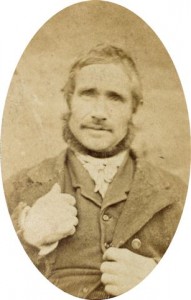
Last December, An Coimisinéir Teanga, Seán Ó Cuirreáin organised a commemoration on the 130th anniversary of the hanging in Galway Gaol of three men for the murder of five people in Maamtrasna. One of those hanged, Myles Joyce, was innocent. A large crowd attended the memorial service, and some were bemoaning the fact that no photograph of Myles existed. But then, eagle-eyed Pádraic Canny from the Joyce Country remembered he had seen a reference to Maamtrasna photographs. It turned out that they existed in a file in the National Library entitled “The Invincibles File”. These had been missed by scholars and researchers up until now, and had never been published.
The General Post Office (10-01-13)
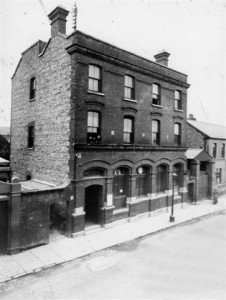
Records show that post office business has been conducted in the Eglinton Street area since the 1850’s. The Ordnance Survey map of 1872 shows the ‘Postal and Telegraph Office’ in the house at the corner of Francis Street and Daly’s Place, where Emerson & Conway solicitors are today. Prior to 1885, the local postmaster Mr. Cornwall provided the premises but as business expanded, the building became too small. It could not accommodate parcels and a separate outside premises for a parcel office was rented at a cost of £15 per annum.The telephone service, like the earlier telegraph was started by private companies. The Post Office took over the telegraph in 1870 and the telephone in 1912.
When Buses Came to Galway (03-01-13)
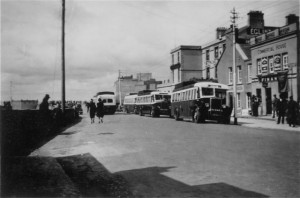
The first public transport system in Galway was the horse drawn tramway. It ran until World War I when the British army commandeered most of the horses. By this time motorised transport was also providing competition, and this speeded up the demise of the tram system. The first buses ran in the streets of Galway in 1919, run by The Galway General Omnibus Company. They started with 3 vehicles, a 20-seater Commer single-decker, a 35-seater charabanc (probably a Lancia) and a 49-seater Karrier double-decker with an open upper deck.All these buses were chain driven and fitted with solid tyres and they relied on carbide lamps to show the driver where he was going at night. Breakdowns were frequent;
Galway Dock and Harbour Improvements, 1833 (07-06-2012)
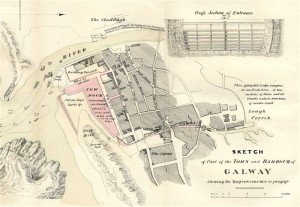
“The town of Galway possesses many advantages of position for trade, which has hitherto been much cramped for want of adequate and secure accommodation for the shipping; great facilities present themselves for the construction of a wet dock. Several engineers of eminence agreed upon what ought to be the general nature of the work; and Mr. Kilally, adopting their principles, has recently drawn up the requisite plans and specifications, upon which a contract will be entered in to immediately; the preliminary steps having been taken of the purchase by inquisition of the premises and ground to be occupied”.
OUR LADY'S BOYS CLUB (31-05-12)

Our photograph today is of a 1950’s soccer team representing Our Ladys Boys Club, taken in Terryland where facilities were quite primitive at the time and as you can see, the preferred mode of transport apart from shanks mare was cycling. The team is, back row, left to right; Patsy Burke, Richie O’Connor, Brod Long, Brendan Dowling, Paddy Power, Tommy Carr, Paddy Beatty. In front are Danny Collins, Billy Carr, John Rushe, Steve Mannion, Gus O’Connor and Barney Birkett. The Boys club was founded in 1940, a time when there were no after-school recreational facilities for boys in working class areas. The Jesuit community gave them the use of a clubhouse at the back of the Columban Hall and here the boys were involved in many activities and prepared for later life. They were taught self respect, loyalty, how to help others and the importance of team spirit.
A FUNERAL PASSING EYRE SQUARE (24-05-12)
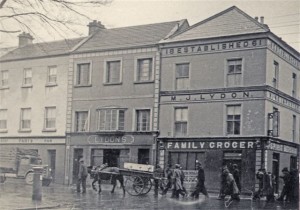
There is something profoundly lonely about this photograph of a funeral procession passing the corner of Eyre Square and Forster Street. It was probably taken during the war when petrol was very scarce. As you can see, the coffin is being carried on a horse drawn cart. It might have been coming from the station but it is more likely it was on its way from St. Patrick’s Church to the New Cemetery. The heavy rain makes the day even more miserable.The pub on the corner was Number 18, Eyre Square and originally opened in 1861. It belonged to Michael J. Lydon who came originally from Knockferry.
LANDING FISH AT BLACKROCK (17-05-12)
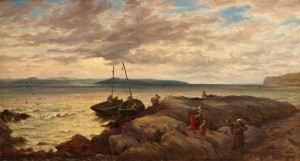
Our image today is of a painting entitled “Morning – Landing Fish at Blackrock, Galway Bay” by an English painter named Thomas Rose Miles dated c. 1895. There is probably a little artistic licence taken but it is a fascinating study of the bay which is very difficult to capture in paint. There is just a thin strip of land visible on the far side, nothing very dramatic, and of course the light and colours change constantly. The sunlit area we see on the Clare coast corresponds to Ballyvaughan and the landmass to the west of that has been darkened for artistic effect. Though they are probably not visible in this reproduction, there are a lot of fishing boats on the bay.
ST. MARY’S COLLEGE, ALMOST 100 YEARS OLD
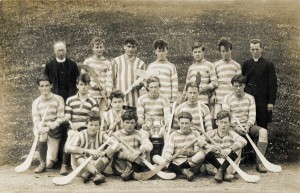
Our photograph today shows the St. Mary’s College hurling team which won the competition played between their school, Garbally and St. Flannan’s in 1924. The diocesan magazine “The Mantle” published this image and provided an update on the players in 1959, so the notes after their names describe their status in 1959.Back row, left to right; Right Rev. Monsignor J. Mitchell, President of the College; Ben Farrell, a native of Craughwell, ordained a priest for Galway 1932, went to Australia, died in the diocese of Bathurst ; Willie Fahy, Castlegar, now a parish priest in Australia ;
